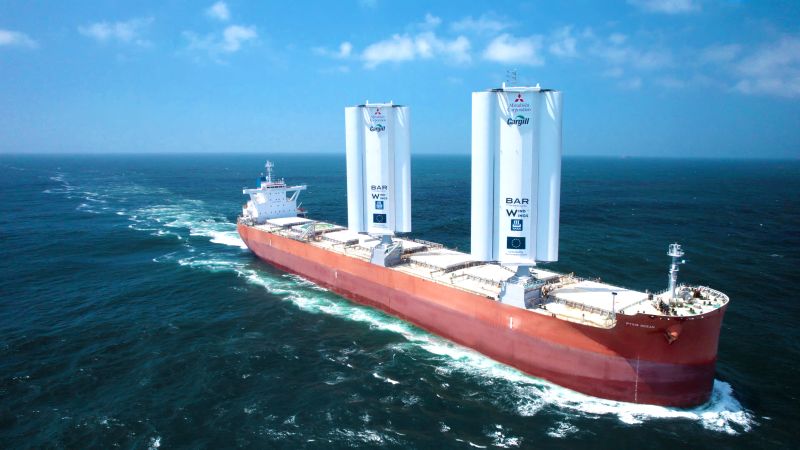
Wind-powered cargo ship sets sail in a move to make shipping greener
A large red cargo ship named Pyxis Ocean set out on its maiden voyage this month. But unlike most others before it, this one is powered, in part, by wind.
The ship, chartered by US shipping firm Cargill, has been retrofitted with two WindWings – large steel sails 37.5 meters (123 foot) tall, designed by UK company BAR Technologies and produced by industrialization partner Yara Marine Technologies.
The wings are expected to generate emissions savings of up to 30%. If used in combination with alternative fuels, developers say that the savings would be even higher.
The voyage, which began in China and is currently headed towards Brazil, will put the technology to the test.
Wind power
The shipping industry produces more than one billion tons of carbon dioxide each year, accounting for nearly 3% of human-caused global emissions. In July, the sector pledged to reduce its planet-heating pollution to net zero “by or around 2050.” The use of wind is one way towards this. While it’s not a new concept (sailing ships date back more than 5,000 years) new wind assisted propulsion technologies have been making an appearance in recent years.
Huge kites and rotor technologies have been tried on cargo ships in attempts to reduce their dependence on diesel. But according to the International Windship Association, there are only around 20 large commercial vessels equipped with wind propulsion operating today.
The entrance of Cargill – one of the world’s largest agricultural traders, transporting around 225 million tons of commodities each year – could be influential.
Scaling up
One of the major benefits of the WindWings project, which is co-funded by the European Union, is that it offers a retrofit solution that could help to reduce the carbon emissions of existing vessels. According to Cargill, 55% of the world’s cargo fleets are up to nine years old.
Not only do the wings help to reduce the emissions of the ship, they will also help vessel owners meet new industry rules on energy efficiency, and save money by cutting fuel consumption, according to Cargill. The company says that on an average global route, WindWings can save 1.5 metric tons of fuel per wing per day, with the possibility of saving more on trans-ocean routes. The firm notes that this could become even more important when using greener future fuels (such as ammonia and methanol), which are expected to cost more.
Experts have noted that for wind-assisted technologies to become widespread, their cost must be in line with the fuel savings they provide.
The WindWings are made from steel and glass composite, and before the ship enters a port or passes under a bridge, they can be folded on deck to avoid collisions. They were fitted onto Pyxis Ocean in Shanghai, before the ship traveled to Singapore, where it was loaded with fuel and officially launched.
The performance of the wings will be carefully monitored along the route so that improvements can be made to the design before it is produced at scale.
Cooper says that BAR Technologies already has other contracts in the works, including a vessel chartered by Vale that is equipped with four WindWings and is scheduled to set sail from Shanghai in September.
“We look forward to supporting the global shipping industry as it transitions to greener, cleaner propulsion and design,” he says.
